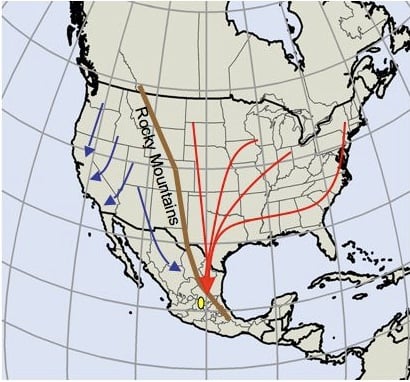Migration
The yearly migration of eastern North American monarch butterflies is a visually and biologically breathtaking event.

During the fall migration, millions of butterflies from the US and Southern Canada make the yearly journey (red lines) to overwinter in roosts in a small area in central Mexico (yellow oval), with some having traveled distances approaching 2,000 miles. The over-wintering sites are clustered in the mountains of Michoacán in central Mexico—a handful of oyamel fir groves totaling just over three hundred square miles.
The population of monarch butterflies west of the Rocky Mountains also undergoes a fall migration (blue lines), with most overwintering in roosts along the Pacific Coast, but the distances traveled are far less than those of the eastern population. Moreover, the western range of overwintering areas is not as concentrated as that in the east. Because of the distances traveled and the nature of the focal stopping point, our research has focused on the eastern North American population. It should be noted that the more north-easterly population of migrants in the west apparently can move through Nevada, Utah and Arizona to overwinter in central Mexico.
Migratory monarchs are at least two generations removed from those that made the journey the previous fall. They have never been to the overwintering sites before, and have no relatives to follow on their way. There must be a genetic program underlying the butterflies' migratory behavior. We want to know what that program is, and how it works.